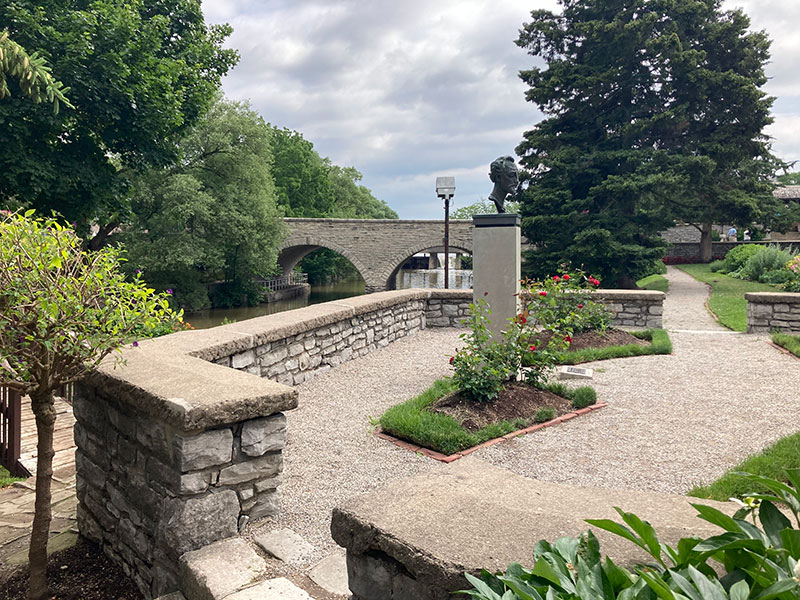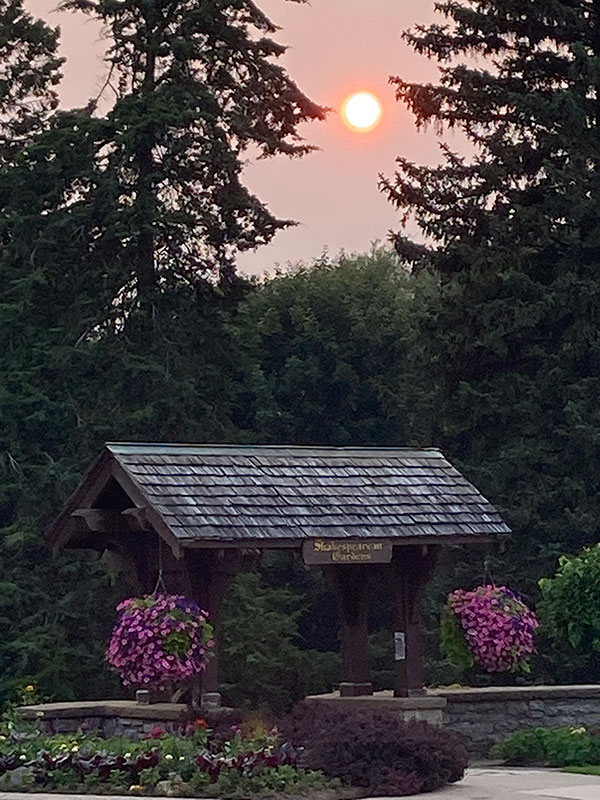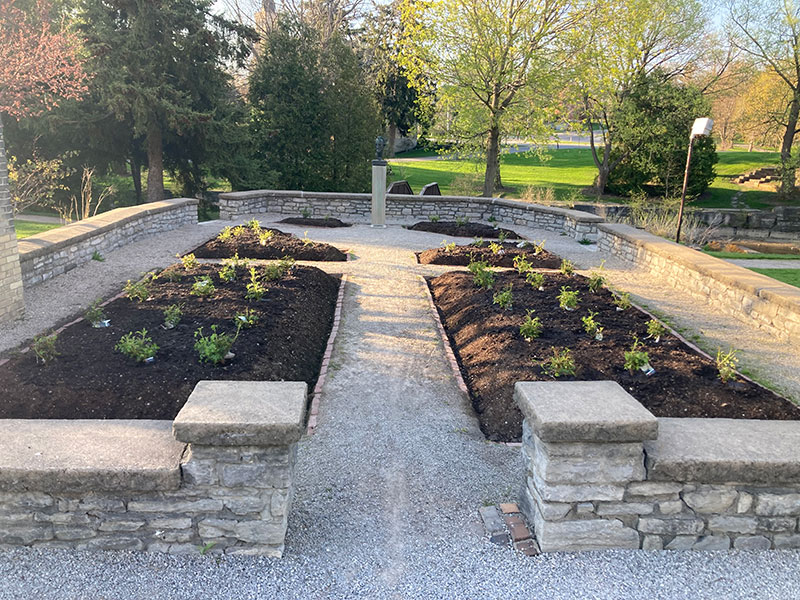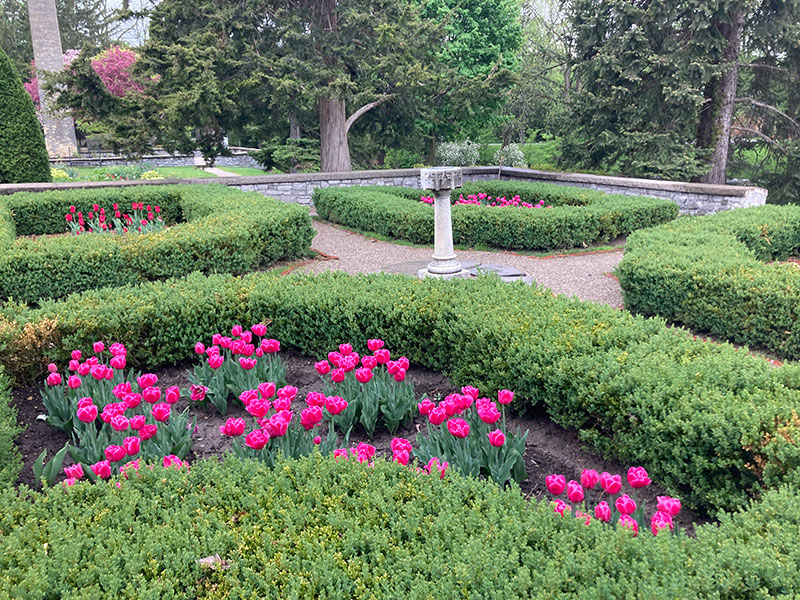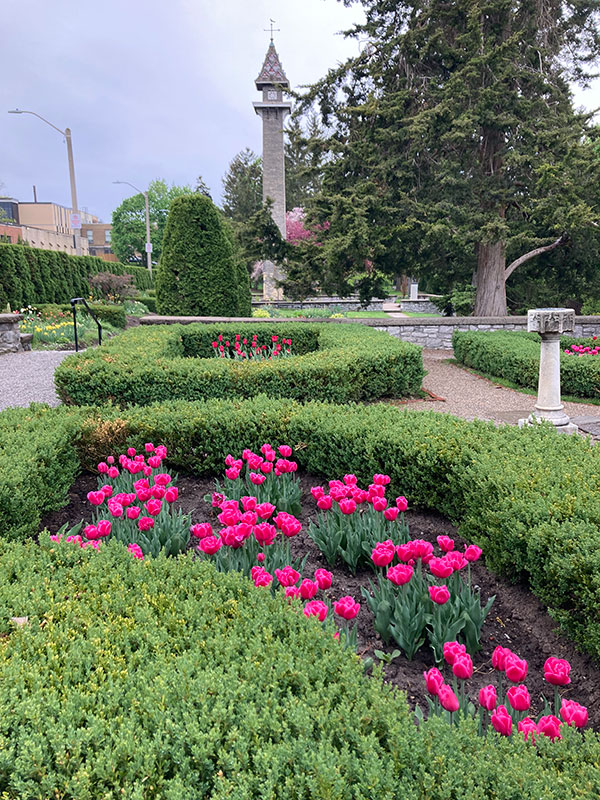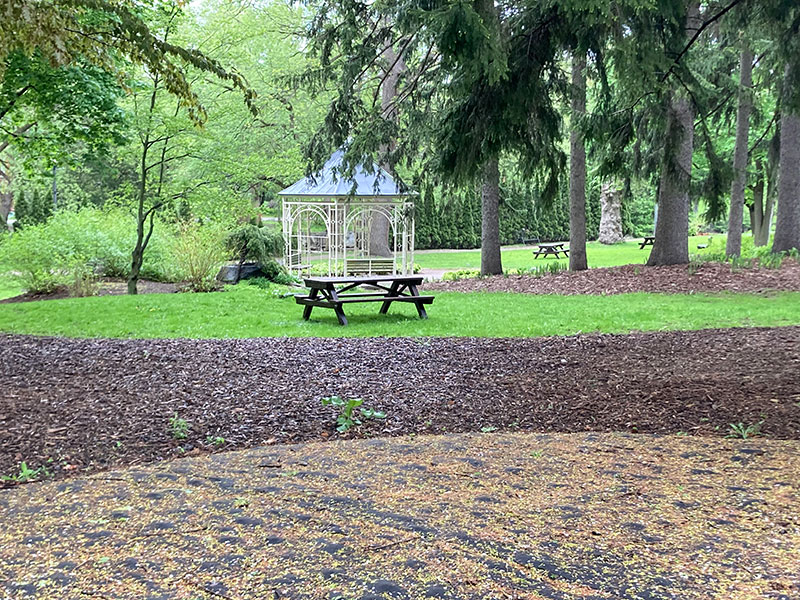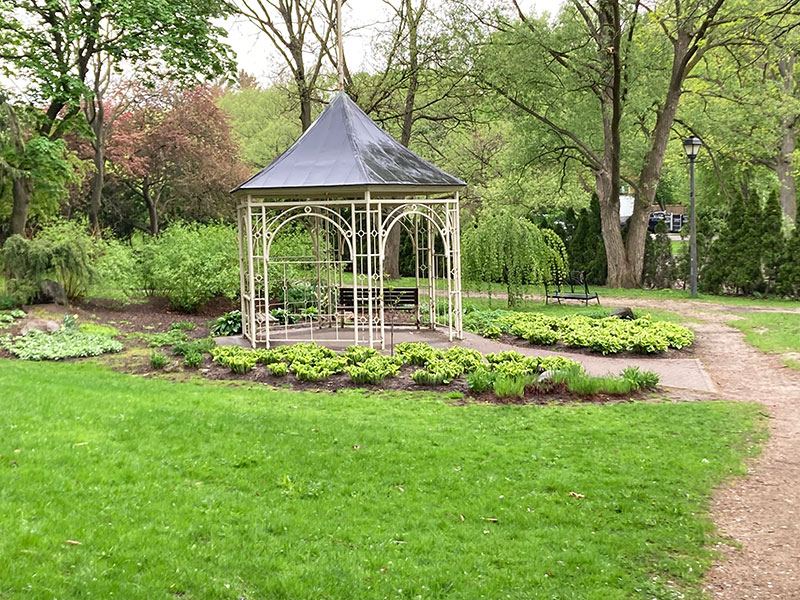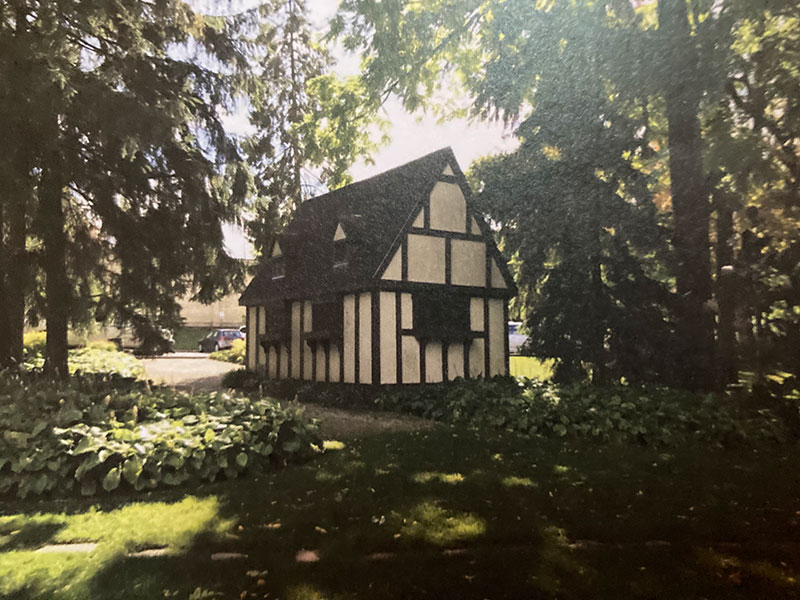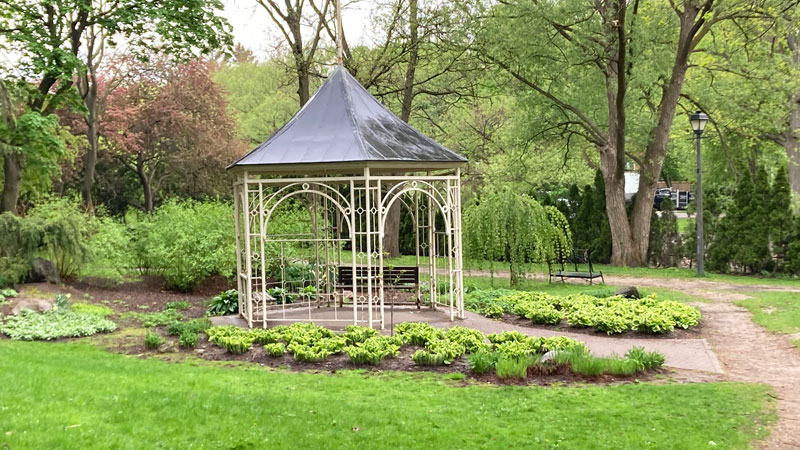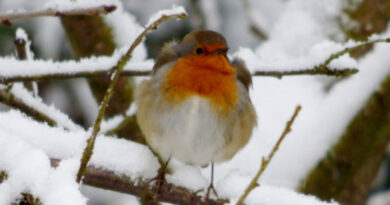Stratford Garden
Situated in the middle of southwestern Ontario, rests the picturesque town of Stratford, famous for its live theatre festival each year, and its more than 175 acres of green space close to the downtown core. But the story about the unusually strong interest in gardens and green open spaces begins 118 years ago with strong voices in the community who had a vision for their city. Once the vision turned into acres of parkland and gardens, world-renowned live theatre came to Stratford and brought new excitement, visibility and attention, to the beautiful formal and open green spaces surrounding the Avon River and downtown areas.
In 1904 The Stratford Parks Board started when a local dentist, Dr. Edward Henry Eidt, expressed great concern about the need for more green open spaces for family recreation and leisure for the downtown area. A strong interest in more public parks was supported by other community leaders such as Thomas Dolan, George McLagan, and Tom (RT) Orr who became early members of the Park Board. Beginning in 1909, as the result of their strong lobbying to City Council, parcels of land started to be purchased for use as parks and parkettes. The purchase and fight for, public gardens and green space, would lead to the vision, and later reality, of an important city landmark, known as the Shakespeare Garden.
The event that started the ball rolling was as a conflict over land use. In the early 1900s, one of the Park Board’s main interests was protecting the area along the Avon River as an area where families could enjoy the setting for recreation and leisure. The area around the river seemed like a good place for a city park. Unfortunately, at that time, the railway company was also interested in this prime location. Supporters of the railway proposal wanted the low-lying creek because it would make an excellent railway siting and track area. RT Orr, and his dedicated supporters realized that their years of hard work, and purchase of properties for parkland close to this area, were now at risk.
The railway suppliers and companies, backed by the business community, lobbied hard for the river site, and were determined to buy this attractive piece of land. On the opposing side, with a vision for parkland in Stratford, RT Orr and his supporters, began a door-to-door campaign to educate the public about the possible loss of a possible grassy and tree-lined park. To decide what the do, the Stratford City Council held a plebiscite vote and asked the people of Stratford to make the choice. In the end, by a small margin, the people of Stratford voted for parkland.
The victory for parkland meant that the community understood the need for natural spaces, and wanted to preserve places where people could enjoy the outdoors. Excited by the result of the plebiscite vote, RT Orr became interested in the idea of creating a Shakespearean Garden near the downtown. Orr’s background in structure and design as an architect, and his interest in history, made him the right person to plan a large-scale garden project that would meet the needs of his community. He looked at park areas along the developing river site, but these areas were either not large enough, not available, or not suitable for what he had in mind.
There was one site that Orr felt would be perfect for a Shakespeare Garden. It was located on a main street, steps from the downtown, with river frontage. Unfortunately, the site was then owned by the Dufton Woolen Mill, was not for purchase, and the very high property values for the land were out of the range for the City to buy.
Orr could not have known that unforeseen events would change the Mill property, and they would happen without warning. At the time of Orr’s search for a site for the Garden, the well-established Dufton Mill had been in operation since the 1870s. There had been a few serious fires over time at the Mill, but in 1922, a catastrophic fire swept through the buildings. The Dufton Family decided not to rebuild.
The Dufton Family set a high price for the property but given the state of the burnout Mill, and the condition of the land after the fire, there were no offers to buy the site. Three years after the fire, the Dufton family accepted the City’s low offer to buy the land; a property that would later be turned into the Shakespeare Garden.
After the purchase, Orr acted quickly to save the stonework, and other materials, left on the Mill property. He knew about what the stone and other construction materials would cost, and that they could be used, or sold, to help pay for the purchase of the Mill site. He realized that new house builders were interested in the valuable quarry stonework left behind after the fire, and that the stone could also be used as part of the Garden design. He organized about 50 workers and seven trucks, and overnight found a secure building to store all the saved stonework for future use.
Although the purchase of the Dufton Mill was made in 1925, and the property was cleared fairly quickly, the property itself sat idle for many years. Eventually, in 1929, a Committee of Council was formed to carry the Shakespeare Garden proposal forward and make it a reality. For many years, the Great Depression slowed down any plans for the Garden, but in 1935 Orr began work again to work on plans for the project. Orr knew that a garden on river frontage, with a story connected to the town’s past and an investment in the city’s future, would need professional garden and landscape design. He contacted a respected Canadian team that had worked for the Niagara Parks Commission. The landscape architect firm of Dunnington Grubb and Stenson were hired to develop the plan for the new Shakespeare Garden.
In 1936, planting began in the Shakespeare Garden. In the summer months, the Governor General of Canada, Lord Tweedsmuir, was invited to Stratford to officially open the Garden. Sir Archibald Flower, from Stratford on Avon in England, came to present an ornate sundial as a gift to recognize the connection between the city of Stratford on Ontario, and Shakespeare’s own birthplace in England. In 1945, the “Sons of England” raised funds to donate a dramatic bust of William Shakespeare and reinforcing the playwright’s, and England’s, connection to Stratford Ontario. The “Sons of England” commissioned Canadian sculptor Cleeve Horne to do the work.
If mid-1930s visitors approached the street entrance (to what would eventually become the Shakespeare Garden), they would see a 65-foot-tall brick smokestack chimney welcoming them into the site. The original brick chimney was once part of the original Dufton Mill, and is the only remaining landmark preserved after the fire swept across the Mill site. This important symbol of the history of the Dufton Mill site was saved and preserved as a way to honour the past as the city moves into the present, and future. (Today, the city of Stratford uses the image of the Dufton smokestack as part of their city logo, to recognize its connection to Stratford’s history.) The chimney remains today as a visible reminder of the city’s history.
In the early years of the Garden’s history, visitors would see a garden plan designed to feature only those plants showcased in Shakespeare’s plays. Herbs such as fennel, rue, tarragon, rosemary, and other perennials such a gout weed were included in the plantings. The length of the Garden was, and still is, 250 feet long, and sits along the edge of the Avon River. The northern edge of the Garden overlooks the river, and includes a small island of about 30 by 130 feet in size. In the original plans, the island was to have a formal element, but for some reason, the design was never completed.
The quarried stone from the Mill site, stored for years under Orr’s direction, was used as the border around each section of the garden, and provided the materials for a formal entrance and steps down into the Garden. In the early years, visitors would stroll along the well-kept path by the river onto a bridge to the small adjacent island. Trees and bushes were planted to provide the hard landscaping for the garden.
Then next stage of the Garden’s development came as a result of Stratford’s own Tom Patterson and his vision, and development, (in 1953) of an internationally acclaimed live theatre festival to take place in the areas around the downtown core. As the Stratford Festival gained popularity, more and more visitors came to see the shows, and to enjoy and walk around the downtown area. The Shakespeare Garden became more established, and greeted a growing number of visitors and theatre patrons from around the world each year.
As the years passed, the Garden was maintained by the Stratford Board of Park management and some additional planting took place. Some of the newer perennials were different than the original Shakespeare-inspired plants. Some new features were also added over time, such a handsome metal gazebo, in the 1970s, donated by the Stratford branch of the Toronto Dominion bank. The gazebo is an oasis on a hot day for guests in the Garden, and the setting for weddings in the fine weather. In addition to this quiet space for reflection, the Shakespeare Garden had, and still has, a lawn feature which leads to a protected woodland area to the west of the property.
As the popularity of the Garden grew over time, two dedicated garden and community advocates began to work on a plan to support ways to enhance and improve the Shakespearean Garden. Beginning in 2019, they approached the Board of Park Management with ideas for improvements and advancements to collectively consider the needs of the 86-year-old garden. This group, now with more members, is known as The Friends of the Shakespeare Garden. These active Stratford citizens continue to make formal presentations to the City’s Board of Park Management with recommendations for maintaining and supporting the site.
Since 2019, The Friends of the Shakespeare Garden, have collected more information about the history of the garden, located the original garden site plans drawn up by the Landscaping firm of Dunnington Grubb and Stenson, and have created the first (ever) visitor’s brochure for the Shakespearean Garden. They have also donated two very large hanging baskets to frame the entrance into the Garden. In a short period of time, they have raised funds for projects, including a large cement urn (donated by the Stratford Horticultural Society) as the new focal point at the end of a long path leading to the woodland end of the Garden. Further fund and friend-raising initiatives have led to a new restoration project of a large bed of peonies to be planted near the front entrance, donated by The Peony Society of Canada. Visitors will also note, as they walk down into the heart of the garden, and look to the west of the knot garden, 50 David Austen roses in white and red colours donated by The Friends of the Shakespeare Garden. The colours of the roses were chosen to replicate the original drawings found for the site.
Today, visitors enter the Garden from the street, walk down the same small set of stairs leading into an open courtyard view, and find themselves adjacent to the 250 feet perennial bed to the left of the main entrance. In recent years, a number of important additions have been made to the garden. The bust, (donated by “The Sons of England”) now oversees the newly planted rose bed. The formal area of the Garden consists of an elegant knot garden with the sun dial (presented by Sir Archibald Flower) as the focus for the plantings.
The Shakespeare Garden is still a work in progress. New projects to enhance and support the Garden continue to be talked about and planned by The Friends of the Shakespeare Garden, as they work with The Board of Park Management. The Garden is a living symbol of the past, present, and the hope of garden enthusiasts, and visitors, for the future.
